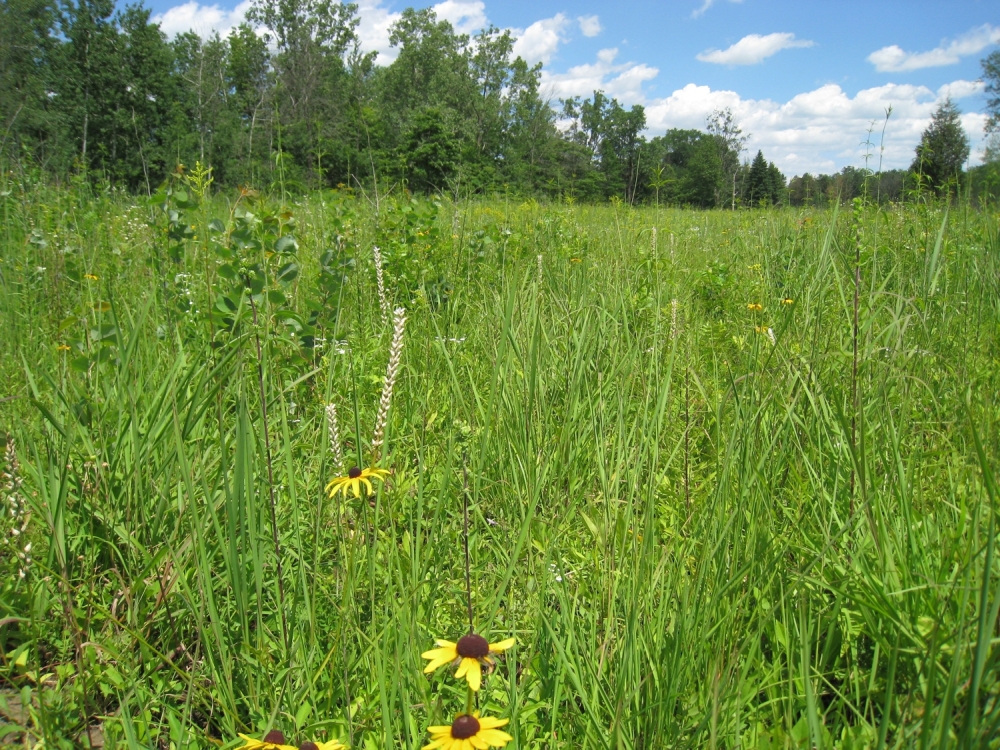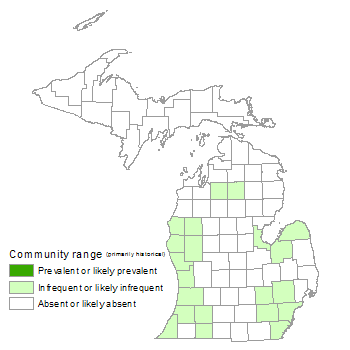Mesic Sand Prairie
Overview
Mesic sand prairie is a native grassland community occurring on sandy loam, loamy sand, or sand soils on nearly level glacial outwash plains and lakeplains in both the northern and southern Lower Peninsula. Sites that support mesic sand prairie experience fluctuating water tables, with relatively high water tables occurring in the spring followed by drought conditions in late summer and fall. Thus, the community contains species from a broad range of moisture classes, but is dominated by species of upland affinity. Dominant grasses include little bluestem (Schizachyrium scoparium), big bluestem (Andropogon gerardii), and Indian grass (Sorghastrum nutans).
Rank
Global Rank: G2 - Imperiled
State Rank: S1 - Critically imperiled

Landscape Context
Mesic sand prairie occurs in shallow depressions within glacial outwash plains and lakeplains, and on old, abandoned glacial lakebeds, stream channels, and river terraces. On these landforms, it can occur as a broad, expansive feature or form a narrow vegetation zone between fire-dependent uplands and open wetlands such as intermittent wetland or coastal plain marsh. Upland communities that border mesic sand prairie are typically fire-dependent savannas, prairies, and forests.
Soils
Soils are predominantly strongly acid to neutral sandy loam and occasionally loamy sand. The dry-mesic to mesic condition of the sandy soils is facilitated by a relatively high water table and, in some sites, by organic content within the sand matrix, which increases water-holding capacity. Mesic sand prairie experiences seasonal water table fluctuations, with the wettest conditions occurring in spring and driest periods in late summer and fall.
Natural Processes
Seasonal and annual water level fluctuations and sandy soils create conditions suitable for plant species representing a broad range of moisture tolerances, primarily species requiring mesic to dry conditions. Prior to European settlement in the early 1800s, fires of natural and anthropogenic origin limited encroachment by shrubs and trees. Fire helps maintain species diversity by facilitating seed germination, opening microsites for seedling establishment and growth of small species, and releasing important plant nutrients that bolster plant growth, flowering, and seed set.
Vegetation
Dominant grasses include little bluestem, big bluestem, and Indian grass. Pennsylvania sedge (Carex pensylvanica) is often important. Low areas transitional to wet-mesic prairie or wet-mesic sand prairie have increased importance of bluejoint grass (Calamagrostis canadensis), cordgrass (Spartina pectinata), sedges (Carex spp.), rushes (Juncus spp.), and bulrushes (Scirpus spp.). Common forbs include colic root (Aletris farinosa), thimbleweed (Anemone cylindrica), spreading dogbane (Apocynum androsaemifolium), arrow-leaved aster (Symphyotrichum urophyllum), tall coreopsis (Coreopsis tripteris), smooth scouring rush (Equisetum laevigatum), flowering spurge (Euphorbia corollata), wild-strawberry (Fragaria virginiana), northern bedstraw (Galium boreale), tall sunflower (Helianthus giganteus), alum root (Heuchera americana), path rush (Juncus tenuis), false dandelion (Krigia biflora), prairie phlox (Phlox pilosa), old-field cinquefoil (Potentilla simplex), black-eyed Susan (Rudbeckia hirta), stiff goldenrod (Solidago rigida), Missouri ironweed (Vernonia missurica), and arrow-leaved violet (Viola sagittata). The following shrubs and trees are occasional to common, especially in fire-suppressed occurrences: red maple (Acer rubrum), quaking aspen (Populus tremuloides), oaks (Quercus spp.), sumacs (Rhus spp.), pasture rose (Rosa carolina), raspberries (Rubus spp.), and sassafras (Sassafras albidum). Canada bluegrass (Poa compressa), an invasive species, is common in some sites.
For information about plant species, visit the Michigan Flora website.
Plant Lists
Graminoids
- big bluestem (Andropogon gerardii)
- blue-joint (Calamagrostis canadensis)
- Pennsylvania sedge (Carex pensylvanica)
- poverty grass (Danthonia spicata)
- rushes (Juncus canadensis and J. tenuis)
- little bluestem (Schizachyrium scoparium)
- Indian grass (Sorghastrum nutans)
- prairie dropseed (Sporobolus heterolepis)
Forbs
- colic root (Aletris farinosa)
- thimbleweed (Anemone cylindrica)
- spreading dogbane (Apocynum androsaemifolium)
- tall green milkweed (Asclepias hirtella)
- butterfly-weed (Asclepias tuberosa)
- white false indigo (Baptisia lactea)
- wild indigo (Baptisia tinctoria)
- Indian paintbrush (Castilleja coccinea)
- bastard-toadflax (Comandra umbellata)
- tall coreopsis (Coreopsis tripteris)
- common rockrose (Crocanthemum canadense)
- showy tick-trefoil (Desmodium canadense)
- flat-topped white aster (Doellingeria umbellata)
- rattlesnake-master (Eryngium yuccifolium)
- flowering spurge (Euphorbia corollata)
- northern bedstraw (Galium boreale)
- bottle gentian (Gentiana andrewsii)
- tall sunflower (Helianthus giganteus)
- alum root (Heuchera americana)
- false dandelions (Krigia biflora and K. virginica)
- round-headed bush-clover (Lespedeza capitata)
- blazing-stars (Liatris aspera, L. scariosa, and L. spicata)
- pale spiked lobelia (Lobelia spicata)
- wild lupine (Lupinus perennis)
- wild bergamot (Monarda fistulosa)
- balsam ragwort (Packera paupercula)
- prairie phlox (Phlox pilosa)
- field milkwort (Polygala sanguinea)
- old-field cinquefoil (Potentilla simplex)
- common mountain mint (Pycnanthemum virginianum)
- black-eyed Susan (Rudbeckia hirta)
- stiff goldenrod (Solidago rigida)
- smooth aster (Symphyotrichum laeve)
- prairie heart-leaved aster (Symphyotrichum oolentangiense)
- Missouri ironweed (Vernonia missurica)
- arrow-leaved violet (Viola sagittata)
Fern Allies
- smooth scouring rush (Equisetum laevigatum)
Shrubs
- American hazelnut (Corylus americana)
- winged sumac (Rhus copallina)
- pasture rose (Rosa carolina)
- northern dewberry (Rubus flagellaris)
- prairie willow (Salix humilis)
- meadowsweet (Spiraea alba)
Noteworthy Animals
Ants, particularly the genus Formica, play an important role in mixing and aerating prairie soils as they continually build and abandon mounds, overturning large portions of prairie soil in the process. Other important species contributing to soil mixing and aeration include moles, mice, skunks, and badgers.
Rare Plants
- Asclepias hirtella (tall green milkweed, state threatened)
- Asclepias purpurascens (purple milkweed, state special concern)
- Baptisia lactea (white false indigo, state special concern)
- Carex tincta (sedge, state special concern)
- Draba nemorosa (whitlow-grass, presumed extirpated from Michigan)
- Eryngium yuccifolium (rattlesnake-master, state threatened)
- Helianthus mollis (downy sunflower, state threatened)
- Lactuca floridana (woodland lettuce, state threatened)
- Oxalis violacea (violet wood-sorrel, state threatened)
- Sisyrinchium farwellii (Farwell’s blue-eyed-grass, presumed extirpated from Michigan)
- Sisyrinchium strictum (blue-eyed-grass, state special concern)
- Sporobolus heterolepis (prairie dropseed, state special concern)
- Strophostyles helvula (trailing wild bean, state special concern)
- Trichostema dichotomum (bastard pennyroyal, state threatened)
- Viola novae-angliae (New England violet, state threatened)
Rare Animals
- Ammodramus henslowii (Henslow’s sparrow, state threatened)
- Ammodramus savannarum (grasshopper sparrow, state special concern)
- Asio flammeus (short-eared owl, state endangered)
- Atrytonopsis hianna (dusted skipper, state threatened)
- Chlosyne gorgone carlota (Gorgone checkerspot, state special concern)
- Chondestes grammacus (lark sparrow, presumed extirpated from Michigan)
- Clemmys guttata (spotted turtle, state threatened)
- Elaphe o. obsoleta (black rat snake, state special concern)
- Emydoidea blandingii (Blanding’s turtle, state special concern)
- Flexamia reflexus (leafhopper, state special concern)
- Lanius ludovicianus migrans (migrant loggerhead shrike, state endangered)
- Microtus ochrogaster (prairie vole, state endangered)
- Phyciodes batesii (tawny crescent, state special concern)
- Pygarctia spraguei (Sprague’s pygarctia, state special concern)
- Schinia indiana (phlox moth, state endangered)
- Sistrurus c. catenatus (eastern massasauga, federal candidate species and state special concern)
- Spartiniphaga inops (spartina moth, state special concern)
- Speyeria idalia (regal fritillary, state endangered)
- Spiza americana (dickcissel, state special concern)
- Sturnella neglecta (western meadowlark, state special concern)
- Terrapene c. carolina (eastern box turtle, state special concern)
Biodiversity Management Considerations
Priorities for conservation of mesic sand prairie include identifying, protecting, and managing existing remnants where they occur. The primary threat to mesic sand prairie is fire suppression. Fire suppression promotes shrub and tree invasion, which significantly reduces graminoid and forb cover. Prescribed fire can be employed to restrict encroaching trees and shrubs, reduce thatch build-up, and promote seed bank expression. Sites impacted by severe encroachment of tall shrubs and trees require an initial step of cutting and herbiciding woody stems. Selective use of herbicide can also be used to control invasive species not reduced or eliminated by application of prescribed fire. Severely degraded sites may require reintroduction of appropriate species and, where feasible, local genotypes.
Monitoring and control efforts to detect and remove invasive species are critical to the long-term viability of mesic sand prairie. Invasive species that threaten the diversity and community structure include glossy buckthorn (Frangula alnus), common buckthorn (Rhamnus cathartica), autumn olive (Elaeagnus umbellata), Eurasian honeysuckles (especially Lonicera morrowii, L. tatarica, and L. xbella), multiflora rose (Rosa multiflora), spotted knapweed (Centaurea stoebe), common St. John’s-wort (Hypericum perforatum), ox-eye daisy (Leucanthemum vulgare), hawkweeds (Hieracium spp.), white sweet-clover (Melilotus alba), yellow sweet clover (M. officinalis), Japanese knotweed (Fallopia japonica), leafy spurge (Euphorbia virgata), wild parsnip (Pastinaca sativa), bouncing bet (Saponaria officinalis), hoary alyssum (Berteroa incana), Canada bluegrass, Kentucky bluegrass (Poa pratensis), smooth brome (Bromus inermis), and timothy (Phleum pratense).
Variation
Sites range from mesic to dry-mesic, with dry-mesic sites lacking species of wetland affinity. Prairie plant species diversity is generally higher in occurrences located in far southwestern Michigan than in those located further east or north, likely due to their closer proximity to the central range of prairie in North America.
Similar Natural Communities
Wet-mesic sand prairie, dry-mesic prairie, dry sand prairie, mesic prairie, and lakeplain wet-mesic prairie.
Places to Visit
- Minong Prairie, Petersburg State Game Area, Monroe Co.
- Pinckney Prairie, Pinckney State Recreation Area, Washtenaw Co.
- Teeple Lake, Highland State Recreation Area, Oakland Co.
Relevant Literature
- Chapman, K.A. 1984. An ecological investigation of native grassland in southern Lower Michigan. M.A. thesis, Western Michigan University, Kalamazoo, MI. 235 pp.
- Faber-Langendoen, D., and P.F. Maycock. 1992. A vegetation analysis of tallgrass prairie in southern Ontario. Pp. 17-32 in Proceedings of the Thirteenth North American Prairie Conference: Spirit of the land, our prairie legacy, ed. R.G. Wickett, P.D. Lewis, A. Woodliffe, and P. Pratt. Department of Parks and Recreation, Windsor, Ontario, Canada. 262 pp.
- Kost, M.A. 2005. Natural community abstract for mesic sand prairie. Michigan Natural Features Inventory, Lansing, MI. 11 pp.
- NatureServe. 2006. NatureServe Explorer: An online encyclopedia of life [Web application]. Version 6.1. NatureServe, Arlington, VA. Available http://www.natureserve.org/explorer. (Accessed: January 12, 2007.)
For a full list of references used to create this description, please refer to the natural community abstract for Mesic Sand Prairie.
More Information
Citation
Cohen, J.G., M.A. Kost, B.S. Slaughter, D.A. Albert, J.M. Lincoln, A.P. Kortenhoven, C.M. Wilton, H.D. Enander, and K.M. Korroch. 2020. Michigan Natural Community Classification [web application]. Michigan Natural Features Inventory, Michigan State University Extension, Lansing, Michigan. Available https://mnfi.anr.msu.edu/communities/classification. (Accessed: December 15, 2025).
Kost, M.A., D.A. Albert, J.G. Cohen, B.S. Slaughter, R.K. Schillo, C.R. Weber, and K.A. Chapman. 2007. Natural Communities of Michigan: Classification and Description. Michigan Natural Features Inventory, Report No. 2007-21, Lansing, MI.


